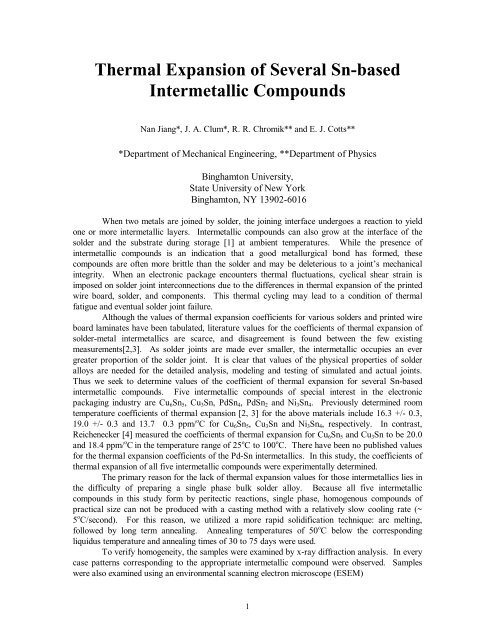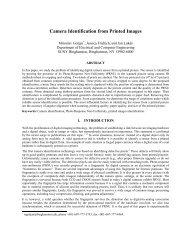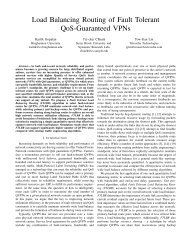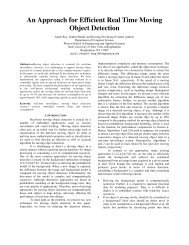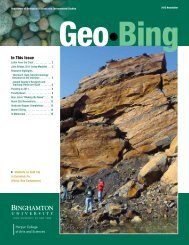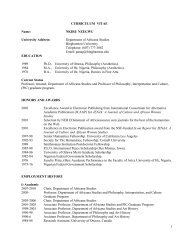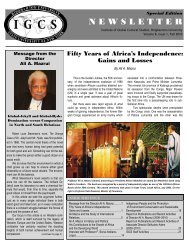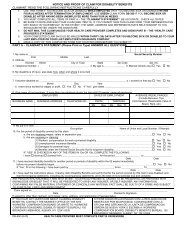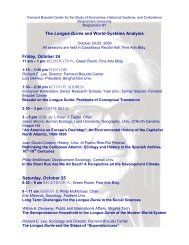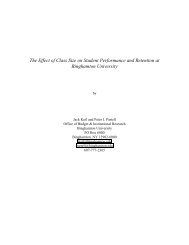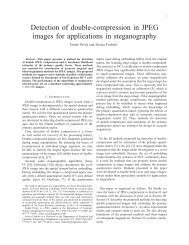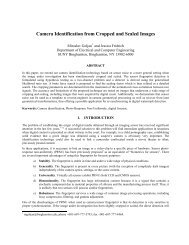Thermal Expansion of Several Sn-based Intermetallic Compounds
Thermal Expansion of Several Sn-based Intermetallic Compounds
Thermal Expansion of Several Sn-based Intermetallic Compounds
You also want an ePaper? Increase the reach of your titles
YUMPU automatically turns print PDFs into web optimized ePapers that Google loves.
<strong>Thermal</strong> <strong>Expansion</strong> <strong>of</strong> <strong>Several</strong> <strong>Sn</strong>-<strong>based</strong><br />
<strong>Intermetallic</strong> <strong>Compounds</strong><br />
Nan Jiang*, J. A. Clum*, R. R. Chromik** and E. J. Cotts**<br />
*Department <strong>of</strong> Mechanical Engineering, **Department <strong>of</strong> Physics<br />
Binghamton University,<br />
State University <strong>of</strong> New York<br />
Binghamton, NY 13902-6016<br />
When two metals are joined by solder, the joining interface undergoes a reaction to yield<br />
one or more intermetallic layers. <strong>Intermetallic</strong> compounds can also grow at the interface <strong>of</strong> the<br />
solder and the substrate during storage [1] at ambient temperatures. While the presence <strong>of</strong><br />
intermetallic compounds is an indication that a good metallurgical bond has formed, these<br />
compounds are <strong>of</strong>ten more brittle than the solder and may be deleterious to a joint’s mechanical<br />
integrity. When an electronic package encounters thermal fluctuations, cyclical shear strain is<br />
imposed on solder joint interconnections due to the differences in thermal expansion <strong>of</strong> the printed<br />
wire board, solder, and components. This thermal cycling may lead to a condition <strong>of</strong> thermal<br />
fatigue and eventual solder joint failure.<br />
Although the values <strong>of</strong> thermal expansion coefficients for various solders and printed wire<br />
board laminates have been tabulated, literature values for the coefficients <strong>of</strong> thermal expansion <strong>of</strong><br />
solder-metal intermetallics are scarce, and disagreement is found between the few existing<br />
measurements[2,3]. As solder joints are made ever smaller, the intermetallic occupies an ever<br />
greater proportion <strong>of</strong> the solder joint. It is clear that values <strong>of</strong> the physical properties <strong>of</strong> solder<br />
alloys are needed for the detailed analysis, modeling and testing <strong>of</strong> simulated and actual joints.<br />
Thus we seek to determine values <strong>of</strong> the coefficient <strong>of</strong> thermal expansion for several <strong>Sn</strong>-<strong>based</strong><br />
intermetallic compounds. Five intermetallic compounds <strong>of</strong> special interest in the electronic<br />
packaging industry are Cu 6 <strong>Sn</strong> 5 , Cu 3 <strong>Sn</strong>, Pd<strong>Sn</strong> 4 , Pd<strong>Sn</strong> 2 and Ni 3 <strong>Sn</strong> 4 . Previously determined room<br />
temperature coefficients <strong>of</strong> thermal expansion [2, 3] for the above materials include 16.3 +/- 0.3,<br />
19.0 +/- 0.3 and 13.7 0.3 ppm/ o C for Cu 6 <strong>Sn</strong> 5 , Cu 3 <strong>Sn</strong> and Ni 3 <strong>Sn</strong> 4 , respectively. In contrast,<br />
Reichenecker [4] measured the coefficients <strong>of</strong> thermal expansion for Cu 6 <strong>Sn</strong> 5 and Cu 3 <strong>Sn</strong> to be 20.0<br />
and 18.4 ppm/ o C in the temperature range <strong>of</strong> 25 o C to 100 o C. There have been no published values<br />
for the thermal expansion coefficients <strong>of</strong> the Pd-<strong>Sn</strong> intermetallics. In this study, the coefficients <strong>of</strong><br />
thermal expansion <strong>of</strong> all five intermetallic compounds were experimentally determined.<br />
The primary reason for the lack <strong>of</strong> thermal expansion values for those intermetallics lies in<br />
the difficulty <strong>of</strong> preparing a single phase bulk solder alloy. Because all five intermetallic<br />
compounds in this study form by peritectic reactions, single phase, homogenous compounds <strong>of</strong><br />
practical size can not be produced with a casting method with a relatively slow cooling rate (~<br />
5 o C/second). For this reason, we utilized a more rapid solidification technique: arc melting,<br />
followed by long term annealing. Annealing temperatures <strong>of</strong> 50 o C below the corresponding<br />
liquidus temperature and annealing times <strong>of</strong> 30 to 75 days were used.<br />
To verify homogeneity, the samples were examined by x-ray diffraction analysis. In every<br />
case patterns corresponding to the appropriate intermetallic compound were observed. Samples<br />
were also examined using an environmental scanning electron microscope (ESEM)<br />
1
Cu 6 <strong>Sn</strong> 5 Cu 3 <strong>Sn</strong> Pd<strong>Sn</strong> 2 Pd<strong>Sn</strong> 4 Ni 3 <strong>Sn</strong> 4<br />
60 o C 18.3 18.2 13.6 15.5 14.6<br />
80 o C 18.5 18.4 13.7 15.6 14.9<br />
100 o C 18.6 18.5 13.8 15.7 15.1<br />
120 o C 19.0 18.7 13.9 15.8 15.2<br />
140 o C 19.4 19.0 14.2 16.0 15.7<br />
160 o C 20.2 19.4 14.3 16.2 16.0<br />
TABLE I<br />
<strong>Thermal</strong> expansion coefficients <strong>of</strong> five intermetallic compounds in the temperature <strong>of</strong><br />
60 o C - 160 o C. All values have the unit <strong>of</strong> ppm/ o C.<br />
equipped with an energy dispersive spectroscopy (EDX) detector. Cu 3 <strong>Sn</strong> alloys appeared to be<br />
homogenous, with no observable segregation or porosity. In Cu 6 <strong>Sn</strong> 5 samples, <strong>Sn</strong>-rich areas were<br />
observed. The area fraction <strong>of</strong> this <strong>Sn</strong>-rich area was determined to be on the order <strong>of</strong> 3%. Defects<br />
in the form <strong>of</strong> micropores were discovered in the arc melted compounds <strong>of</strong> Pd<strong>Sn</strong> 4 , Pd<strong>Sn</strong> 2 , and<br />
Ni 3 <strong>Sn</strong> 4 . The porosity <strong>of</strong> these three samples is on the order <strong>of</strong> 2-5%.<br />
<strong>Thermal</strong> expansion tests were performed with a commercially available thermomechanical<br />
analyzer (TMA). The specimen was heated in a stepwise manner, waiting for complete thermal<br />
<strong>Thermal</strong> expansion coefficient (ppm/ o C)<br />
28<br />
26<br />
24<br />
22<br />
20<br />
18<br />
16<br />
40 60 80 100 120 140 160 180<br />
Temperature ( o C)<br />
Figure 1: A plot <strong>of</strong> the coefficients <strong>of</strong> thermal<br />
expansion as a function <strong>of</strong> temperature for Cu 3 <strong>Sn</strong> (),<br />
Cu 6 <strong>Sn</strong> 5 (O), Cu (a), and <strong>Sn</strong> (/). Values for Cu 3 <strong>Sn</strong> and<br />
Cu 6 <strong>Sn</strong> 5 were obtained in this experiment, values for<br />
Cu and <strong>Sn</strong> were obtained from reference 7. The total<br />
uncertainty <strong>of</strong> the measurements was estimated to be<br />
2% from the combination <strong>of</strong> two sources: the standard<br />
deviation <strong>of</strong> the measurements themselves and that <strong>of</strong><br />
calibration values.<br />
<strong>Thermal</strong> <strong>Expansion</strong> Coefficient (ppm/ o C)<br />
18<br />
17<br />
16<br />
15<br />
14<br />
13<br />
12<br />
11<br />
40 60 80 100 120 140 160 180<br />
Temperature ( o C)<br />
Figure 2: A plot <strong>of</strong> the coefficients <strong>of</strong> thermal<br />
expansion as a function <strong>of</strong> temperature for Pd<strong>Sn</strong> 2 (a),<br />
Pd<strong>Sn</strong> 4 (O), and Pd (). Values for Pd<strong>Sn</strong> 2 and Pd<strong>Sn</strong> 4<br />
were obtained in this experiment, values for Pd were<br />
obtained from reference 7. The total uncertainty <strong>of</strong> the<br />
measurements was estimated to be 2% from the<br />
combination <strong>of</strong> two sources: the standard deviation <strong>of</strong><br />
the measurements themselves and that <strong>of</strong> calibration<br />
values.<br />
2
equilibrium at each intervening temperature. <strong>Thermal</strong> expansion measurements were made on<br />
heating from 50 o C to 170 o C with an isothermal hold <strong>of</strong> 30 minutes at each 20 o C interval. A<br />
heating rate <strong>of</strong> 10 o C/min was used. NIST reference materials [5] SRM 731 (Borosilicate Glass),<br />
SRM736 (Copper) and SRM 738 (Stainless Steel) were used for instrument calibration. Three<br />
samples <strong>of</strong> each material were produced and tested, and for each material between ten and fifteen<br />
runs were performed. <strong>Several</strong> (approximately 25) runs were also performed with a ramping<br />
method for each material where the samples were heated from 50 o C to 170 o C at a constant heating<br />
rate <strong>of</strong> 10 o C. Results obtained with this method did not differ significantly from the stepwise<br />
heating method. Table 1 lists coefficients <strong>of</strong> thermal expansion for all five intermetallic<br />
compounds as a function <strong>of</strong> temperature with the unit <strong>of</strong> ppm/ o C. The total uncertainty <strong>of</strong> the<br />
measurements was estimated to be 2% from the combination <strong>of</strong> two sources: the standard deviation<br />
<strong>of</strong> the measurements themselves and that <strong>of</strong> the calibration values.<br />
At temperatures between 25°C and 100°C we observed that the thermal expansion<br />
coefficient <strong>of</strong> Cu 6 <strong>Sn</strong> 5 is essentially the same as that <strong>of</strong> Cu 3 <strong>Sn</strong> (Figure 1), while both are<br />
significantly higher than that <strong>of</strong> Cu. Another experiment was conducted to investigate the thermal<br />
expansion <strong>of</strong> a phase mixture <strong>of</strong> Cu-<strong>Sn</strong><br />
compounds. Samples <strong>of</strong> the nonstoichiometric<br />
material Cu<strong>Sn</strong> (a mixture <strong>of</strong><br />
Cu 6 <strong>Sn</strong> 5 and Cu 3 <strong>Sn</strong>) were produced by the<br />
arc- melting method and the thermal<br />
expansion coefficients <strong>of</strong> this phase<br />
mixture were determined. The coefficient<br />
<strong>of</strong> thermal expansion <strong>of</strong> this phase mixture<br />
was the same within experimental error as<br />
those <strong>of</strong> Cu 6 <strong>Sn</strong> 5 and Cu 3 <strong>Sn</strong>. Thus, a single<br />
thermal expansion curve may be used to<br />
model the behavior <strong>of</strong> Cu 6 <strong>Sn</strong> 5 , Cu 3 <strong>Sn</strong> or<br />
the phase mixture, in this temperature<br />
range.<br />
We note that the coefficients <strong>of</strong><br />
thermal expansion <strong>of</strong> the intermetallics<br />
investigated were found to be significantly<br />
different than those <strong>of</strong> <strong>Sn</strong> or the base<br />
metal. Comparing the thermal expansion<br />
<strong>of</strong> the two Pd/<strong>Sn</strong> compounds, Pd<strong>Sn</strong> 4 shows<br />
12% higher expansion than that <strong>of</strong> Pd<strong>Sn</strong> 2<br />
and roughly 30% higher expansion than<br />
that <strong>of</strong> Pd (Figure 2). The Ni 3 <strong>Sn</strong> 4<br />
intermetallic compound showed about 6%<br />
higher thermal expansion than that <strong>of</strong> Ni<br />
(Figure 3). The coefficients <strong>of</strong> thermal<br />
expansion for solder depend on its<br />
composition ranging from 20 to 29 ppm/ o C<br />
[6], significantly larger than any <strong>of</strong> the<br />
observed values <strong>of</strong> thermal expansion<br />
coefficients.<br />
Extrapolation <strong>of</strong> the data <strong>of</strong> Fig. 1<br />
indicates that the room temperature<br />
coefficient <strong>of</strong> thermal expansion for both<br />
<strong>Thermal</strong> expansion coefficient (ppm/ o C)<br />
16.0<br />
15.6<br />
15.2<br />
14.8<br />
14.4<br />
14.0<br />
13.6<br />
60 80 100 120 140 160<br />
Temperature ( o C)<br />
Figure 3: A plot <strong>of</strong> the coefficients <strong>of</strong> thermal<br />
expansion as a function <strong>of</strong> temperature for Ni 3 <strong>Sn</strong> 4 (a),<br />
and Ni (). Values for Ni 3 <strong>Sn</strong> 4 was obtained in this<br />
experiment, values for Ni were obtained from<br />
reference 7. The total uncertainty <strong>of</strong> the<br />
measurements was estimated to be 2% from the<br />
combination <strong>of</strong> two sources: the standard deviation <strong>of</strong><br />
the measurements themselves and that <strong>of</strong> calibration<br />
values<br />
3
Cu 6 <strong>Sn</strong> 5 and Cu 3 <strong>Sn</strong> is 18 ppm/ o C. This value can be compared to previously determined values <strong>of</strong><br />
16.3 and 20.0 ppm/ o C for Cu 6 <strong>Sn</strong> 5 and 19.0 and 18.4 ppm/ o C for Cu 3 <strong>Sn</strong> [3,4]. The differences<br />
between these results may be the result <strong>of</strong> differences in the microstructure <strong>of</strong> the samples<br />
investigated. For instance, the samples <strong>of</strong> Ref. 3 were small grained (nanometer length scale) from<br />
HIP (hot isostatic pressed) material, in contrast to the very large grained material <strong>of</strong> the present<br />
study.<br />
Our results demonstrate that although differences exist between the coefficient <strong>of</strong> thermal<br />
expansion <strong>of</strong> the intermetallics in the respective systems, more emphasis should be placed on the<br />
greater differences that exist between the intermetallics and their respective basis metals and/or<br />
solders. These differences provide insight on the long term effect <strong>of</strong> thermal cycling performance<br />
<strong>of</strong> soldered joints.<br />
Acknowledgments<br />
This research was funded by the Integrated Electronic Engineering Center at the State University <strong>of</strong><br />
New York at Binghamton. The IEEC receives funding from the New York State Science and<br />
Technology Foundation, the National Science Foundation, and a consortium <strong>of</strong> industrial members.<br />
References<br />
[1] Woodgate, R.W, Handbook <strong>of</strong> Machine Soldering, (John Wiley and Sons, New York,<br />
1983, Chapter 2).<br />
[2] R. J. Fields, S. R. Low III, and G. K. Lucey, Jr, The Metal Science <strong>of</strong> Joining, (The<br />
Minerals, Metals & Materials Society, 1992), pp. 165-173.<br />
[3] R. J. Schaefer, F. S. Biancaniello, and R. D. Jiggetts, The Metal Science <strong>of</strong> Joining, (The<br />
Minerals, Metals & Materials Society, 1992), pp. 175-181.<br />
[4] W. J. Reichenecker, Insulation/Circuits, 27, 104 (1981).<br />
[5] National Institute <strong>of</strong> Standard and Technology, Gaithersburg, MD 20899.<br />
[6] K. R. Stone, R. Duckett, S. Muckett, and M. E. Warwick, Brazing and Soldering, 4, 20<br />
(1983).<br />
[7] Y. S. Touloukian, <strong>Thermal</strong> expansion, metallic elements and alloys, (IFI/Plenum, 1975).<br />
4


